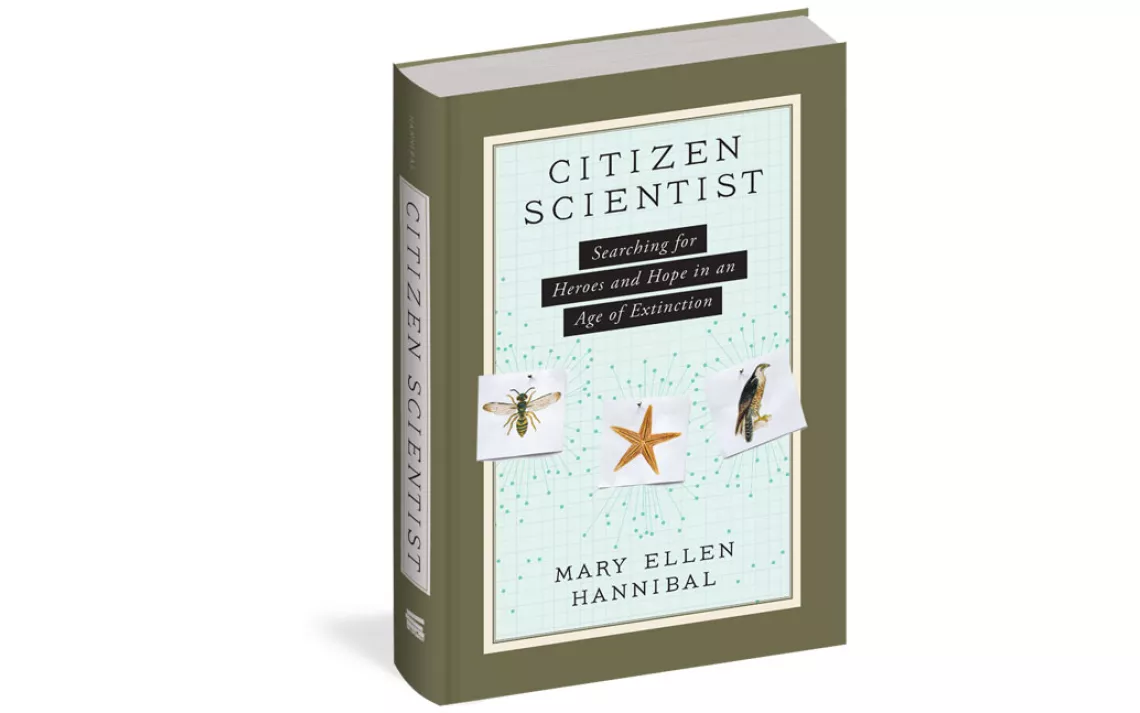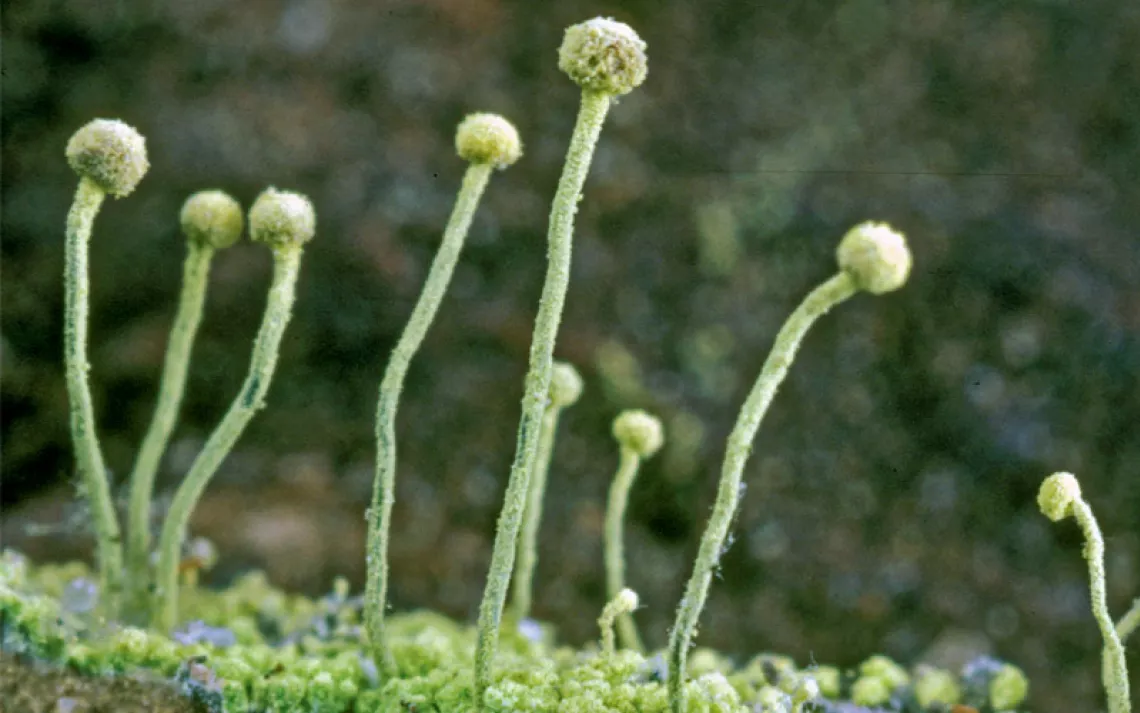How Amateur Scientists Are Unlocking the Secrets of California’s Redwood Forests
An excerpt from the new book Citizen Scientist

Citizen Scientist | Photo courtesy of The Experiment
Emily Burns is a very fine name and suits the person who bears it, but I persist in wanting to call her “Fern.” This is not only because, for more than four years now, Burns has been running Fern Watch, a citizen science project she rather brilliantly conceived to track climate change in the redwood forests along their native range, from the Oregon border down to Big Sur. Burns is fresh-faced and petite, and she told me that one day back in 2008 she was making her rounds in the Humboldt redwoods and registered the obvious—proliferant western swordferns towered over her head. “Down below Santa Cruz, they come up to my knees,” she said. Redwood forests are not just made of trees, but also include many associated species, especially western swordferns. “Ferns are bigger, and there are more of them where there’s more water—more rain and more fog. In a dry year, the ferns will show stress that is much harder to detect in the trees themselves,” she said.
“Aren’t redwoods a relictual species?” I asked her one day, which was something of a taunt. Redwood trees are of an ancient lineage. In the days of dinosaurs, redwoods ringed the whole planet. Today, three species of redwood survive: the giant sequoia, Sequoiadendron giganteum, which is the heaviest of living things; the coast redwood, Sequoia sempervirens, of which members are the tallest of living things; and the dawn redwood, Metasequoia glypostroboides, a relative of the previous two found in the United States, rediscovered in China in 1944. Today, the historic range of the giant sequoia and the coast redwood is limited to a fog belt along the West Coast. On the one hand, things look very grim for the native range. The milieu these trees have been adapted to for hundreds of millions of years is on speed dial for some kind of facelift, probably a botched one, thanks to climate change. A certain sort of scientist makes the observation that it’s kind of miraculous these giants have lasted this long here, and maybe it’s time for them to go. This perspective brings outrage to the pretty face of Emily Burns. “These trees have a fierce life force,” she retorted. “They have survived conditions we can only guess at. I don’t think we should just write them off.”
Burns is mostly a cool scientist, but when her morality and commitment come to the fore, I’m reminded of the opening line to Charlotte’s Web: “Where’s papa going with that ax?” I’m convinced that Fern Arable, the character who memorably preserves the life of a certain pig named Wilbur, grew up to become Emily Burns, PhD, science director of the Save the Redwoods League.
A couple of years ago, I followed Burns with a small group of citizen scientists into the woods around Chabot Space & Science Center in Oakland, California, to take the measure of ferns therein. It was a rainy day, but once under the trees’ canopies we were splashed only by an occasional droplet, and these seemed to be coming from the trees themselves, rather than from any clouds above them. The forest around Chabot is pretty easy to walk through, the ground carpeted with fragrant fallen leaves and duff. It is a tidy woods. Even as I was thinking that the space between the trees seemed cleared for an unfolding fairy tale, we passed a ship-like wooden structure probably built for that purpose. “People are always trying for something primordial in here,” Burns remarked. Just a few days before, she had accompanied a reporter and photographer in here to document the last remnants of a historic stump. Reportedly, this was an especially tall redwood that had been used by ship captains as a sight line to help them avoid crashing on the so-called Blossom Rocks in San Francisco Bay—before the tree was felled during the Gold Rush for logs. Burns told me they came upon a bevy of naked women in nymph-like poses arrayed along a fallen redwood trunk. “The male photographer was fully clothed,” she drily remarked. “It was so embarrassing, I kept my head down as we walked past them!”
Ironically, people can stage their fantasies in here partly because this is at least a third-growth forest. A month or so later, I went with Burns to the Grove of Old Trees in Sonoma County, a 28-acre remnant forest that has never been logged and has been protected since 2000 by the Save the Redwoods League. The trees are staggering, but the ground is a dense tangle of vegetation. Nobody’s posing naked in there. Whereas the ferns in the East Bay redwoods seem judiciously placed, in the Grove of Old Trees, they are in many cases obscured by other plants, including small trees, and measuring them is a bit of a trick. It’s hard to tell where one fern ends and another begins.
The East Bay redwoods were mercilessly logged several times. By 1893, Dr. William Gibbons, one of the medical doctors who was an early member of the California Academy of Sciences, was already doing historical ecology to discern the outlines of what had once been hundreds of acres of redwood trees. Traipsing among a “sea of stumps,” he discerned “very substantial hints of a very ancient history of this patch of forest overlooking Oakland and now so nearly extinct….” He observed that the “hidden depths where we build securely our villages and cities hold records yet to be unfolded.” Gibbons showed the remnant forest to John Muir and Alfred Russel Wallace, who both decried its demise. That didn’t stop it from being logged again once the subsequent generation grew up tall. As would seem to be the perpetual case, when developers want to build something, the forest becomes timber.
Burns made an early academic splash before she had her PhD in hand. One of her professors at UC Berkeley, Todd Dawson, had shown that in addition to soaking up the moisture from fog through their roots, redwood trees make substantial use of it directly through their needles. Burns set about studying whether the same might hold true for the plants associated with redwoods. Her 2009 paper, “Foliar water uptake: a common water acquisition strategy for plants of the redwood forest,” shows that, yes, the same fascinating modus operandi exists among eight dominant plants in the system, including ferns, shrubs, broadleaf, and coniferous trees. “I didn’t think that it was going to be unique to redwoods,” Burns said. “But I had no idea it would be so common.” All these species absorb rain, dew, and fog water directly into their leaves, or in the case of the trees, through their crowns.
The phenomenon goes a long way toward explaining how redwoods have persisted in California’s Mediterranean climate, with our protracted dry spells. The answer is fog. One reason we still have redwoods is because of oceanic upwelling, the same off-coast event that brings a fantastic panoply of sea life to feast around the Farallon Islands. Wind currents blowing offshore between March and September kick deep, cold water (full of nutrients for the kelp, inverts, fish, and marine mammals), and when the cold hits the hot summer air, the result is fog. Fog is held to the coast by mountain ranges that prevent its immediate dissipation, and redwoods and their vegetative ilk grab ahold of it. Redwoods intercept enough fog with their massive crowns that fog provides 20 to 40 percent of overall precipitation required by the tribe.
Fog is generally cold, but it’s also a proverbially hot topic in research on climate change impacts because of this capacity to compensate for lower rainfall in places like California. But the complexities of fog are just beginning to be unpacked. Research published by Dawson and Jim Johnstone in 2010 shows that fog has decreased by 33 percent over the past century, and trends continuing in this direction could stress the redwoods. At around the same time, another set of researchers evidenced fog increasing rather than decreasing, due to the hotter temperatures brought to us courtesy of climate change. The apparent contradiction is nobody’s mistake but reflects the complexity of when and where you study fog. One place to find a more definitive guide to fog impacts on redwoods is in the actual trunks of the trees. Dawson’s research today is focused on using isotope analysis to actually discern the markings of fog versus rain, hot years versus cool, right in the substance of the carbon and oxygen atoms that make up the trees' cellulose.
In 2009, Chabot Space & Science Center approached Burns to help develop a citizen science project. Chabot is one of 12 science institutions around the country collaborating on a “Communicating Climate Change” network, and according to Burns, “redwoods were the iconic obvious habitat.” She suggested tracking sword fern response to weather over time, partly because it is so easy for people to grasp that, yes, a bigger swordfern is getting more water than a smaller one. Armed with the field biologists’ usual arsenal of tape measure and clipboard, Burns monitors transects in 10 redwood forests with the assistance of her education and interpretation manager, Deborah Zierten, who brings hundreds of school kids traipsing into the forest each year to help.
Burns, Zierten, and a shuffling cast of citizen scientists and interns count up fern fronds, measuring them and noting evidence that insects have dined out here or not. Those little spots on the underside of some fronds are spore sacs and indicate fertility. I did not know that! So far Burns’s data shows some change in the ferns in some places. In the Oakland site, nothing statistically significant. In other places, she’s found a huge drop in size and health of ferns, but said, “We can’t pinpoint the cause yet. Dryness is part of it. Herbivory is part of the equation, too. Caterpillars are breaking the ends of the fronds, so when the fern matures, it can’t grow as much as it could otherwise. Maybe we’re looking at natural ebbs and flows. Maybe the drought is affecting the herbivores more than it is directly affecting the ferns.” Burns’s questions about her data explain why she needs a lot of it over a long period of time, so that discernable patterns can emerge.
“The beginning of the citizen science project was a pivot point for me,” Burns said. “I switched from just having an academic perspective to thinking about effective dialogue with the public. How could my research be more applied—how can I help land managers in the face of climate change? I think this focus made me competitive for the league job.” Burns started in 2010 and dove into the League’s Redwoods and Climate Change Initiative (which began in 2009). She brought the Fern Watch project along with her and started another one for good measure, Redwood Watch. This ambitious program has been running for several years, with a substantial assist from Rebecca Moore’s Google Earth Outreach. While Burns perhaps finds “exposure” most often by looking upward to the top of a tree that is literally out of sight, with Redwood Watch her ambition matches Moore’s global perspective. She wants to know where each and every redwood tree lives today all around the globe. And she wants each and every one of us to help her count them.
 The Magazine of The Sierra Club
The Magazine of The Sierra Club







